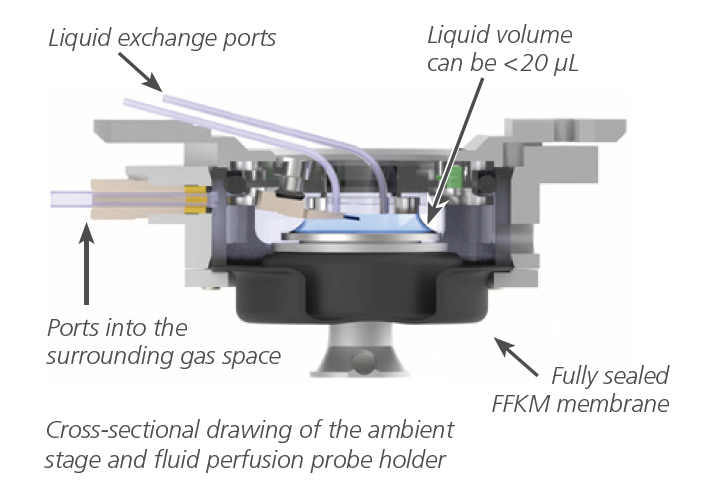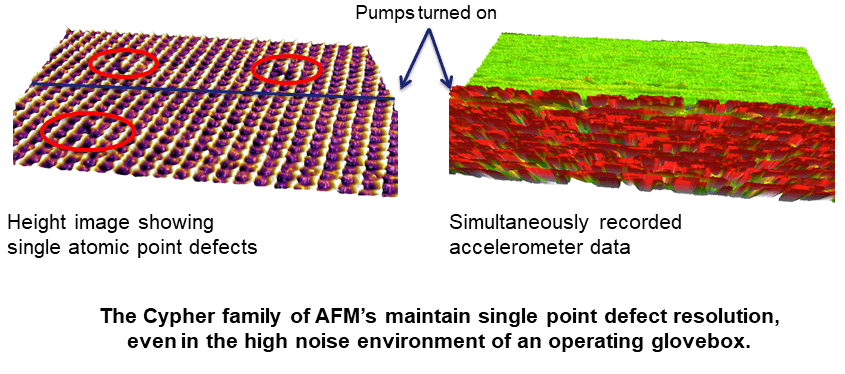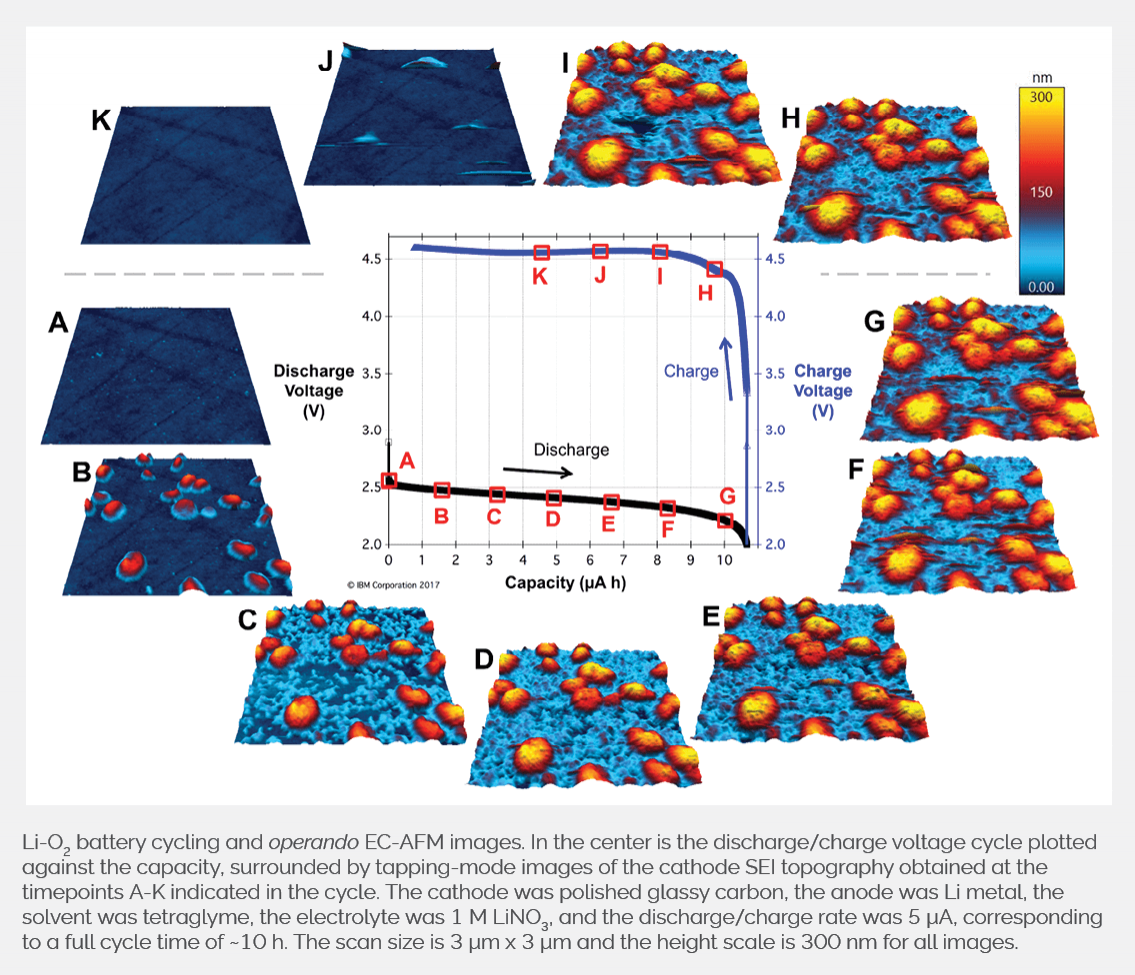AFM Systems
AFM Accessories
Learning
Contact Us

The Cypher ES is the only atomic force microscope designed from the ground up to support exceptional environmental control. This tightly integrated approach results in environmental control that both works better and is easier to use than that found on other AFM’s. The Cypher ES environmental control capabilities include the ability to operate in sealed, controlled gas or liquid environments, perform temperature and humidity control, take in situ measurements within an electrochemical cell, and even operate in a glovebox.
This page describes each of these environmental capabilities in more detail along with the unique benefits that they provide.
Get information from an AFM expert
The Cypher ES is the only AFM with a fully sealed pressure-tight sample cell. This innovative design is the foundation of all Cypher ES environmental control capabilities. Whether one is heating or cooling the sample, controlling the humidity, operating in a dry or inert atmosphere, or using an electrochemical cell, it is crucial that the cell can be fully sealed. Only then can one be confident that the environment is controlled and stable, the sample is protected, and the AFM is safe from leaks.
Most AFM’s rely on a thin rubber gasket that is lightly compressed between the sample cell and the probe holder. This creates a “soft-sealed” cell that is not pressure tight and will frequently leak. This inferior approach is taken because the scanner motion in these AFM’s would be distorted by more secure fully sealed designs. Chemical compatibility is often compromised too because very soft materials like silicone must be used, which precludes the use of many solvents and other chemically aggressive solutions.
The Cypher ES, in contrast, creates a seal between the sample stage and the sample cell using a fully sealed elastomeric bellows. While flexible, it is constructed of thick, tough, highly chemical resistant FFKM elastomer (Kalrez equivalent). It is secured to both parts with steel flanges that tightly clamp and seal the interfaces. The scan motion is not distorted by the bellows because of the unique design of the Cypher ES scanner, which uses a high-stiffness flexure and powerful direct-drive piezo stacks. The probe holder then seals into the sample cell with an O-ring that fully seals the interface. The O-ring is provided in both FKM (Viton equivalent) for less demanding applications and FFKM for applications requiring ultimate chemical compatibility. These are the same design principles that are used to seal other laboratory instrumentation where environmental control is critical.
The result is a fully sealed cell that reliably controls the sample environment, protects both the sample and the AFM, and is easy to setup and use. The cell even includes an integrated pressure sensor that can quickly verify that the cell is air-tight up to 5 psi (~35 kPa).
Many classes of samples including polymers, piezo and ferroelectric samples, and magnetic materials exhibit phase transitions and other thermal effects. The ability to heat samples in situ while imaging with AFM therefore greatly expands the range of characterization. The Cypher ES is available with a High Temperature Sample Heater capable of heating samples from ambient to up to 250 °C. The heater works together with the fully sealed sample cell, which allows samples to be heated under inert atmospheres to prevent oxidation and other undesired surface reactions.
The heater integrates simply into the Cypher ES scanner. Setup consists of a single screw that clamps it in place, one plug that connects directly to the scanner, and samples mount magnetically, as usual. This is unlike many AFM’s that require a separate electronic controller, extra cables, and even external pumps to circulate cooling fluid to prevent overheating the AFM scanner. The Cypher ES makes imaging with temperature control as easy as imaging under ambient conditions.
The tightly integrated design allowed Asylum Research engineers to carefully balance out thermal expansion effects. This keeps thermal drift extremely low even while actively heating, which means that the sample region of interest remains in the scan area. This enables another feature not available on most AFM’s, the ability to program a defined temperature ramp profile along with defined soak / dwell segments. The AFM can be setup to continuously capture images as the temperature slowly ramps, enabling phase transitions to be visualized as a time-lapse process instead of manually incrementing the temperature setpoint in between images.
Imaging remains stable during imaging thanks to blueDrive photothermal excitation, which replaces the conventional tapping piezo with a power-modulated laser that directly drives the cantilever oscillation. In conventional AFM’s, the sensitivity of the tapping piezo changes slightly due to local heating, which results in changes in the cantilever tapping amplitude. The user must adjust the amplitude setpoint to compensate and maintain good imaging conditions. The blueDrive photothermal excitation mechanism, in contrast, is temperature invariant and therefore the amplitude remains constant and imaging remains stable without any user intervention. This means that you won’t miss any sample dynamics during the heating process.
Many other types of samples and processes exhibit temperature-dependent behavior, often over a smaller temperature range slightly above or below ambient temperature. These include biomolecules and biomolecular assemblies, crystal growth and etch processes, molecular self-assembly, and other examples of interfacial physics and surface chemistry. For these types of samples, the Cypher ES Heater-Cooler stage is the ideal solution. It enables temperature control from 0 to 120 °C in both liquid and gas sample environments. Like the High Temperature Sample Heater, the Heater-Cooler integrates tightly with the Cypher ES scanner and works together with the fully-sealed sample cell. It is so simple to use that many researchers use it routinely, even just to ensure that their measurements are consistently made under the same conditions (e.g. 25 °C).
Just as with the High Temperature Sample Heater, users can expect ultra-stable imaging while using the Heater-Cooler thanks to a design that minimizes thermal drift and the stable amplitude response provided by blueDrive photothermal excitation. The sample temperature is directly controlled from software, enabling either fixed setpoints or controlled ramp and soak / dwell segments. With the Cypher ES, sample temperature becomes just another easily controlled experimental variable
One of the biggest advantages of atomic force microscopy is that samples and processes can be visualized in a wide variety of environments, including liquids. For biological samples this often means water or aqueous buffer solutions. But the Cypher ES also allows imaging in a broad range of other liquids, including organic solvents and ionic liquids. Again, the fully sealed sample cell is fundamental to making these measurements simple and safe. The cell can be used with either a fixed volume of liquid or configured to enable liquid perfusion. Either way, one can be confident that the liquid will remain contained and the sealed chamber will equilibrate to prevent evaporation and resulting concentration changes.
The benefits of blueDrive photothermal excitation become even greater in liquids. Those with experience using conventional AFM’s will know that cantilever tuning in liquid is normally much more complex than in air. The tapping piezo shakes the whole AFM, exciting spurious mechanical resonances that couple into the cantilever response, resulting in a “forest of peaks.” It can be difficult to know which peak to tune and use. But blueDrive eliminates this problem because it directly excites the cantilever without exciting other system resonances. So the cantilever resonance peak in liquid is just a clean, clear, and easy to tune as what you see in air. Slight temperature variations or changes in the fluid volume cause the amplitude response to change over time when using a tapping piezo. However, blueDrive keeps the amplitude stable even during fluid heating and fluid perfusion, which maintains high quality imaging without any user adjustments.
In addition to imaging in dry gases and liquids, the Cypher ES can also be used to characterize samples in gases with controlled humidity. Controlling the humidity provides a way to control the hydration of the sample in between the extremes of dry gas and liquid environments. Humidity often has a large effect on friction and other interactions at interfaces since adsorbed water layers contribute to capillary forces and can influence other surface forces. The fully sealed sample cell is again the key component that enables this capability. An integrated miniaturized humidity sensor allows direct measurement of the relative humidity inside the cell. The humidity can be controlled by either flowing through a gas source with the desired humidity or the bellows of the cell can be filled with saturated salt solutions, which can be selected to provide specific humidity levels once they equilibrate in the cell.

For some materials like reactive metals (lithium, sodium, etc.) used in energy storage, 2D materials, and certain photovoltaic materials, even more stringent environmental control is required not just for preserving the sample but also sometimes for operator safety. These materials are reactive with oxygen and/or water and they are therefore handled in controlled glovebox environments where the oxygen and water level can be reduced to sub-ppm levels.
Operating under glovebox conditions is easily done on the Cypher ES by either of two methods. First, the fully sealed sample cell can be removed from the AFM and placed in a glovebox. There, the sample can be prepared, placed in the cell, and sealed. The cell can then be moved out of the glovebox and placed back in the AFM, all while maintaining the inert atmosphere inside the cell. No other commercial AFM allows for this unique workflow, which enables the AFM to remain easily accessible in the lab for other projects that do not require inert conditions. The second option is to place the entire Cypher inside a glovebox. For conventional AFM’s, this comes with unavoidable tradeoffs in terms of both performance and ease of use. However, Cyphers maintain their ease of use and ultrahigh resolution performance even in the noisy, high vibration environment of a glovebox.

The Cypher ES is the ideal AFM for monitoring nanoscale surface changes during electrochemical reactions like those involved in batteries and corrosion. The Cypher ES electrochemical cell integrates within the fully sealed sample cell, which provides a controlled environment, limits evaporation, and provides secondary containment of leaks from the cell. The ultrahigh resolution of the Cypher ES and ease with which blueDrive enables imaging in liquids makes EC-AFM measurements easier than ever before.
The EC cell and probe holder are available in both PEEK and PPS materials for compatibility with the broadest range of electrolytes. The dish-like cell creates a well-defined surface area on the working electrode to allow for quantitative EC measurements while limiting the volume to conserve reagents and allowing the use of low surface tension electrolytes. A ring-shaped counter electrode reduces directional artifacts by producing a more uniform potential gradient.
For lithium battery research and other sensitive applications, the Cypher ES can be used with the EC cell within a glovebox. Unlike most AFM’s, the Cypher ES maintains its full performance and ease of use even within a glovebox.

Learn How We Can Improve Your Research
Contact us to discuss how environmental control can help drive your research forward, and to request pricing for new systems, upgrades or individual accessories.
The environmental control capabilities described above are available on both the Cypher ES and Cypher VRS AFM platforms.
Existing Cypher S systems can also be upgraded to the Cypher ES or Cypher VRS to enable the use of these accessories.